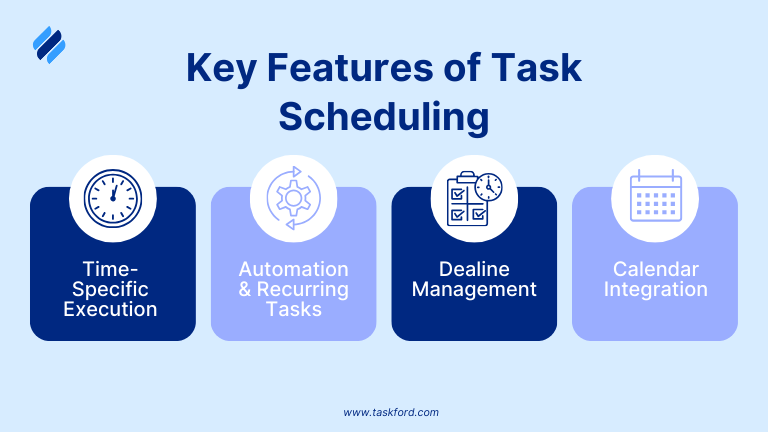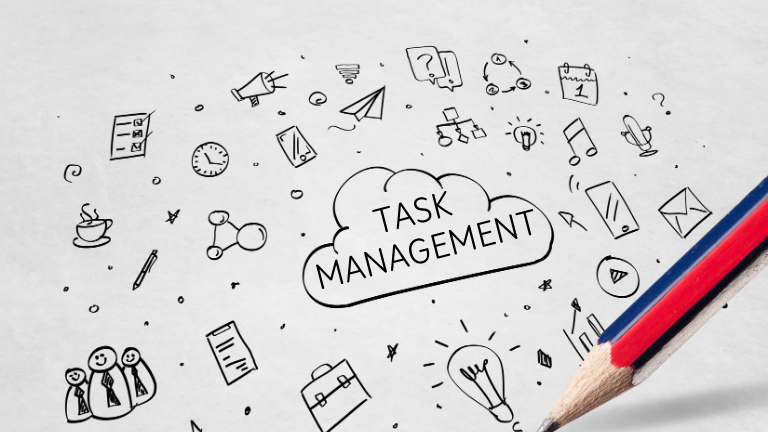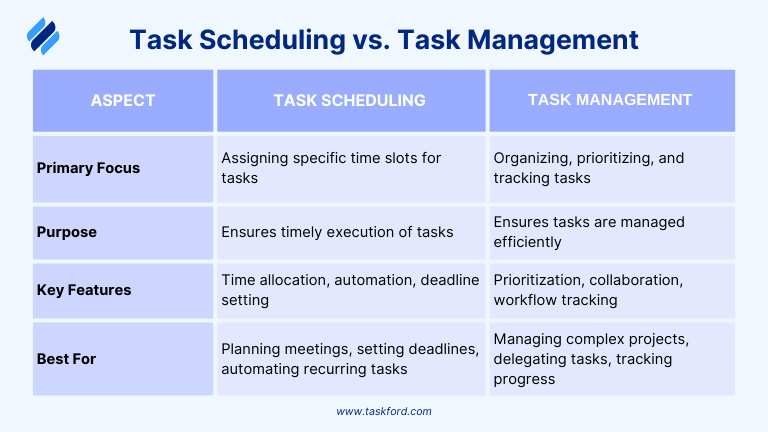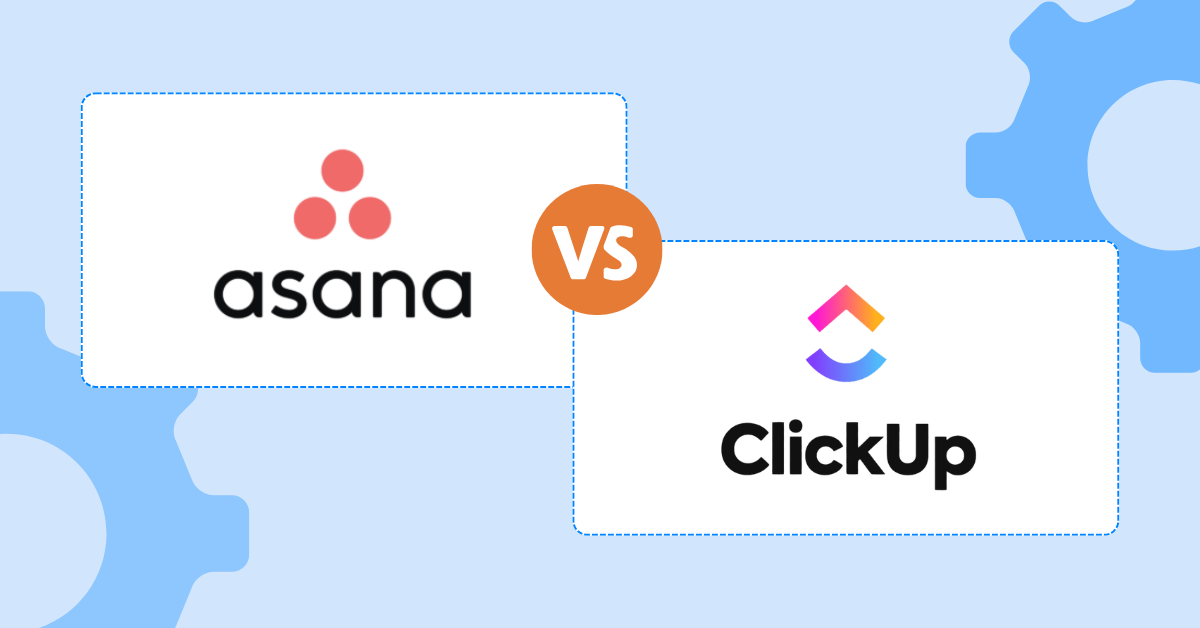Task Scheduling vs. Task Management: What's the Difference?
Learn the difference between task scheduling and task management, and discover strategies to optimize time and streamline workflows effectively.
Have you ever felt overwhelmed with an endless list of tasks, despite using various productivity tools? You’re not alone. Many professionals and teams struggle to stay on top of their work because they confuse task scheduling with task management. While both are essential for staying organized, they serve different purposes.

Understanding the difference can save you hours of wasted time, improve efficiency, and help you meet deadlines without unnecessary stress. Whether you're an entrepreneur, project manager, or freelancer, knowing how to leverage both task scheduling and task management can boost your productivity and improve workflow.
This guide will break down the key differences, explain why both are essential, and provide actionable tips to help you master both scheduling and task management effectively.
What is Task Scheduling?
Task scheduling is the process of planning, assigning, and organizing tasks within specific time frames to ensure timely execution and efficient use of resources. It is a structured approach that helps individuals and teams stay organized by setting deadlines, automating repetitive tasks, and avoiding time conflicts.
At its core, task scheduling focuses on WHEN a task should be completed, ensuring that work is allocated properly throughout the day, week, or month. It is commonly used in personal productivity, team collaboration, and project management, helping to maintain workflow consistency and prevent last-minute rushes.

Key features of Task Scheduling:
Task scheduling is a critical component of effective project management, ensuring that tasks are completed within designated time frames and resources are utilized efficiently. Key features of task scheduling include:
- Time-Specific Execution – Task scheduling revolves around assigning specific time slots for tasks, ensuring they are completed within a defined timeframe. This structured approach helps individuals and teams stay organized and productive.
- Automation & Recurring Tasks – Many tasks, such as weekly team meetings, monthly invoice reminders, or daily reports, follow a recurring pattern. Task scheduling tools allow automation of these repetitive activities, reducing manual effort and ensuring consistency.
- Deadline Management – Scheduled tasks come with clear deadlines, helping individuals and teams maintain accountability and complete work on time. Deadlines act as checkpoints, ensuring that tasks do not get delayed or forgotten.
- Calendar Integration – A strong visual representation of tasks on a calendar helps prevent scheduling conflicts and provides an overview of upcoming responsibilities. This feature ensures that time is allocated efficiently without overlapping commitments.

Where It’s Used:
- Meeting project deadlines and tracking deliverables
- Balancing workloads across teams to avoid burnout
- Automating recurring tasks such as reports, follow-ups, or approvals
- Managing personal time effectively by allocating work to specific time slots
Benefits of Task Scheduling:
- Improved Time Allocation Task scheduling ensures that time is distributed efficiently, allowing individuals and teams to focus on high-priority tasks without distractions. By assigning specific time slots, it prevents wasted time and ensures a well-balanced workflow.
- Reducing Last-Minute Rush A well-structured schedule minimizes the chances of tasks piling up at the last minute. By planning ahead and setting deadlines, task scheduling reduces stress and improves the overall quality of work.
- Enhancing Productivity with Automation Many scheduling tools offer automation features such as recurring tasks, reminders, and workflow integrations. These automations reduce manual effort, streamline operations, and allow employees to focus on more strategic work.
By leveraging these benefits, businesses and individuals can maintain a smooth workflow, meet deadlines consistently, and boost overall efficiency.
What is Task Management?
Task management is the process of planning, tracking, prioritizing, and organizing tasks to ensure work is completed efficiently and effectively. Unlike task scheduling, which focuses primarily on WHEN a task should be done, task management encompasses WHAT needs to be done, WHO is responsible, and HOW tasks fit into broader project goals.
It is an essential part of personal productivity and project management, helping individuals and teams stay organized, maintain accountability, and ensure deadlines are met without overwhelming workloads. Task management provides visibility into progress, ensuring that tasks move seamlessly from planning to completion.

Where It’s Used:
- Project management and team collaboration.
- Organizing work processes and tracking deliverables.
- Prioritizing tasks based on urgency and importance.
Key Features of Task Management
Task management goes beyond just setting deadlines; it involves structuring and overseeing tasks to align with business goals and team priorities. The key features include:
- Task Prioritization Not all tasks hold equal importance. Task management systems allow users to prioritize high-impact tasks while deferring less urgent ones. Prioritization methods like the Eisenhower Matrix or MoSCoW Method help teams focus on what truly matters.
- Workflow Organization & Task Dependencies Tasks often rely on other tasks being completed first. Task management tools help define dependencies, ensuring tasks follow a logical sequence. This prevents bottlenecks and ensures smooth execution in project workflows.
- Collaboration & Delegation In a team environment, it enhances collaboration by allowing team members to assign tasks, track progress, and communicate in one place. Managers can delegate tasks, monitor workloads, and ensure team members are aligned on responsibilities.
- Progress Tracking & Reporting A key aspect of task management is monitoring the status of tasks—whether they are pending, in progress, or completed. Many tools provide dashboards, reports, and notifications to keep teams informed and adjust plans as needed.

Benefits of Task Management:
- Better Organization and Clarity
Task management helps break down large projects into manageable steps. It eliminates confusion by clearly defining what needs to be done, who is responsible, and when it should be completed. - Increased Productivity and Efficiency
By structuring tasks properly, teams can work smarter, not harder. Task management reduces wasted time searching for information, waiting on approvals, or handling redundant tasks. - Improved Accountability and Transparency
With clear task assignments and progress tracking, teams stay accountable. Managers can easily track individual contributions, ensuring responsibilities are evenly distributed and work is completed on time. - Reduced Stress and Work Overload
When tasks are properly planned, categorized, and prioritized, employees avoid the chaos of last-minute deadlines and excessive workloads. A structured task management system promotes a healthier work environment.
Task Management vs. Task Scheduling: How They Work Together
Task management and task scheduling are two distinct but interconnected processes that, when combined, create a highly efficient workflow. While task scheduling ensures tasks are completed on time, task management ensures they are organized, prioritized, and executed effectively.

For instance, a marketing team working on a product launch can utilize task management to break down the project into actionable tasks, such as content creation, design approvals, and social media strategy. At the same time, task scheduling ensures these tasks are assigned specific deadlines, preventing last-minute bottlenecks.
By integrating both approaches, teams can stay organized, meet deadlines consistently, and maintain an efficient workflow—allowing them to work smarter, not harder.
Tactics for Effective Task Scheduling
Implementing the right tactics for task scheduling can significantly enhance productivity, streamline workflows, and ensure that deadlines are met without unnecessary stress. Here are key tactics to improve your task scheduling strategy and make better use of your time.
1. Schedule Tasks Based on Availability
Assigning tasks without considering your or your team’s availability can lead to overbooked schedules, missed deadlines, and inefficient workdays. To schedule tasks effectively:
- Assess workload capacity – Ensure that individuals have enough bandwidth to complete assigned tasks.
- Avoid back-to-back scheduling – Leave space for breaks and unforeseen adjustments.
- Match tasks with energy levels – Plan complex tasks during peak productivity hours and reserve low-effort tasks for energy dips.
- Account for time zone differences when working with remote teams to prevent scheduling conflicts.
By aligning tasks with availability, you can ensure a smoother workflow and better time management.
2. Prioritize Tasks Based on Importance and Urgency
Not all tasks are equal in importance. Prioritizing the right tasks ensures that critical work is completed on time while preventing distractions from low-impact tasks.
-
Use the Eisenhower Matrix to categorize tasks:
- Urgent & Important – Complete these immediately.
- Important but Not Urgent – Schedule these strategically.
- Urgent but Not Important – Delegate when possible.
- Neither Urgent nor Important – Eliminate or deprioritize.
-
Rank tasks by deadline sensitivity – Ensure that high-priority tasks are scheduled earlier in the day or week.
-
Balance long-term projects with daily tasks – Avoid focusing only on urgent work while neglecting strategic goals.
Prioritizing correctly ensures that essential tasks are tackled first, reducing unnecessary stress.
3. Set Realistic Time Blocks for Each Task
Scheduling tasks without realistic time estimates can cause delays, frustration, and an overpacked schedule. To improve time management:
- Estimate task durations accurately – Use past experience or time-tracking tools to set realistic completion times.
- Schedule buffer time between tasks – Allow for unexpected delays or transitions between tasks.
- Follow the 80/20 rule – Allocate 80% of your time to scheduled tasks and leave 20% open for unforeseen work.
- Use techniques like timeboxing – Dedicate fixed time slots to specific tasks (e.g., 90 minutes for deep work).
By setting achievable time blocks, you prevent task spillover and maintain a structured schedule.
4. Use Task Scheduling Software to Stay Organized
Manual scheduling can lead to missed deadlines, forgotten tasks, and inefficiencies. Task scheduling software helps you:
- Automate recurring tasks to save time.
- Sync tasks with calendars to avoid scheduling conflicts.
- Assign and delegate tasks easily for team collaboration.
- Get real-time notifications and reminders to stay on track.
Some of the best task-scheduling tools include:
- Google Calendar & Microsoft Outlook – Ideal for scheduling meetings and managing time effectively.
- Clickup & Monday.com – Comprehensive tools that combine task scheduling with project management.
- Trello & Asana – Visual boards are used to track deadlines and prioritize tasks.
- Foat & Smartsheet– Best for managing team workloads and resource planning.
- TaskFord – Excellent for task scheduling and management, offering capacity management, resource planning, and a visual calendar to keep tasks on track
Using the right software ensures that your schedule is always accessible, structured, and easy to adjust.
Final Thoughts
Effective task scheduling goes beyond setting deadlines—it’s about managing time strategically, improving efficiency, and streamlining workflows. By using smart scheduling techniques, automation, and the right tools, individuals and teams can reduce inefficiencies, minimize last-minute stress, and maximize productivity.
While task management prioritizes and organizes work, task scheduling ensures tasks are executed at the right time without conflicts or overload. When combined, they enhance collaboration, create smoother operations, and maintain a balanced workload, leading to better focus, improved time management, and overall efficiency.
Making work simpler,
smarter, and more connected
Join our waitlist and be notified first.

Related Blog
Subscribe for Expert Tips
Unlock expert insights and stay ahead with TaskFord. Sign up now to receive valuable tips, strategies, and updates directly in your inbox.






